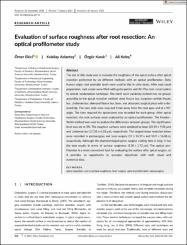Evaluation of surface roughness after root resection: An optical profilometer study
Künye
Ekici, Ö., Aslantaş, K., Kanık, Ö., & Keleş, A. (2021). Evaluation of surface roughness after root resection: An optical profilometer study. Microscopy Research and Technique, 84(4), 828-836.Özet
The aim of this study was to evaluate the roughness of the apical surface after apicalresection performed by six different methods with an optical profilometer. Sixtyhuman single root premolar teeth were used in this in vitro study. After root canalpreparation, root canals were filled with gutta-percha and AH Plus root canal sealersby lateral condensation technique. The teeth were randomly divided into six groupsaccording to the apical resection method: steel fissure bur, tungsten carbide fissurebur, Lindeman bur, diamond fissure bur, laser, and ultrasonic surgical piezo with a dia-mond tip. The root ends were resected 3 mm away from the root apex and at a 90 angle. The time required for apicectomy was recorded for each group. After apicalresection, the root surfaces were analyzed by an optical profilometer. The Kruskal–Wallis method was used to analyze the differences between groups. The significancelevel was set at 5%. The roughest surfaces were obtained by laser (25.54 ± 9.01μm)and Lindeman bur (17.35 ± 6.03μm), respectively. The longest mean resection timeswere recorded in piezosurgery and laser surgery (57 ± 14.39 s and 50.9 ± 16.86 s),respectively. Although the diamond-tipped piezo surgical cutting time is long, it hasthe best results in terms of surface roughness (5.50 ± 1.73μm). The optical pro-filometer is a more convenient tool for evaluating the surface after apical surgery, asit provides an opportunity to evaluate objectively with both visual andnumerical data.
















